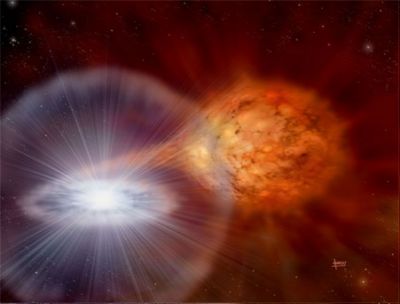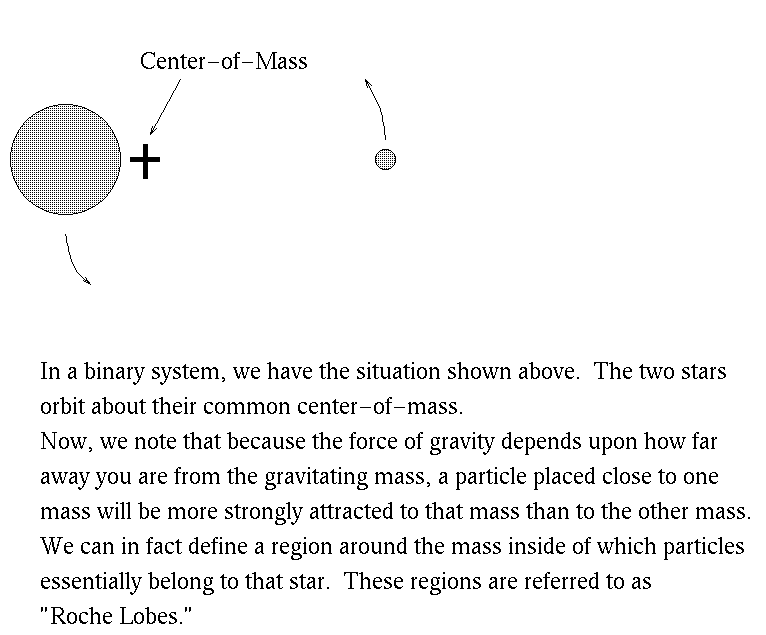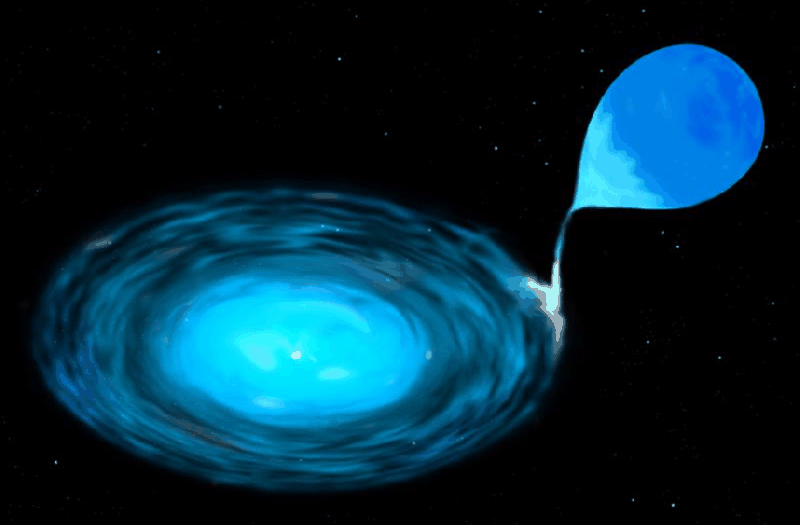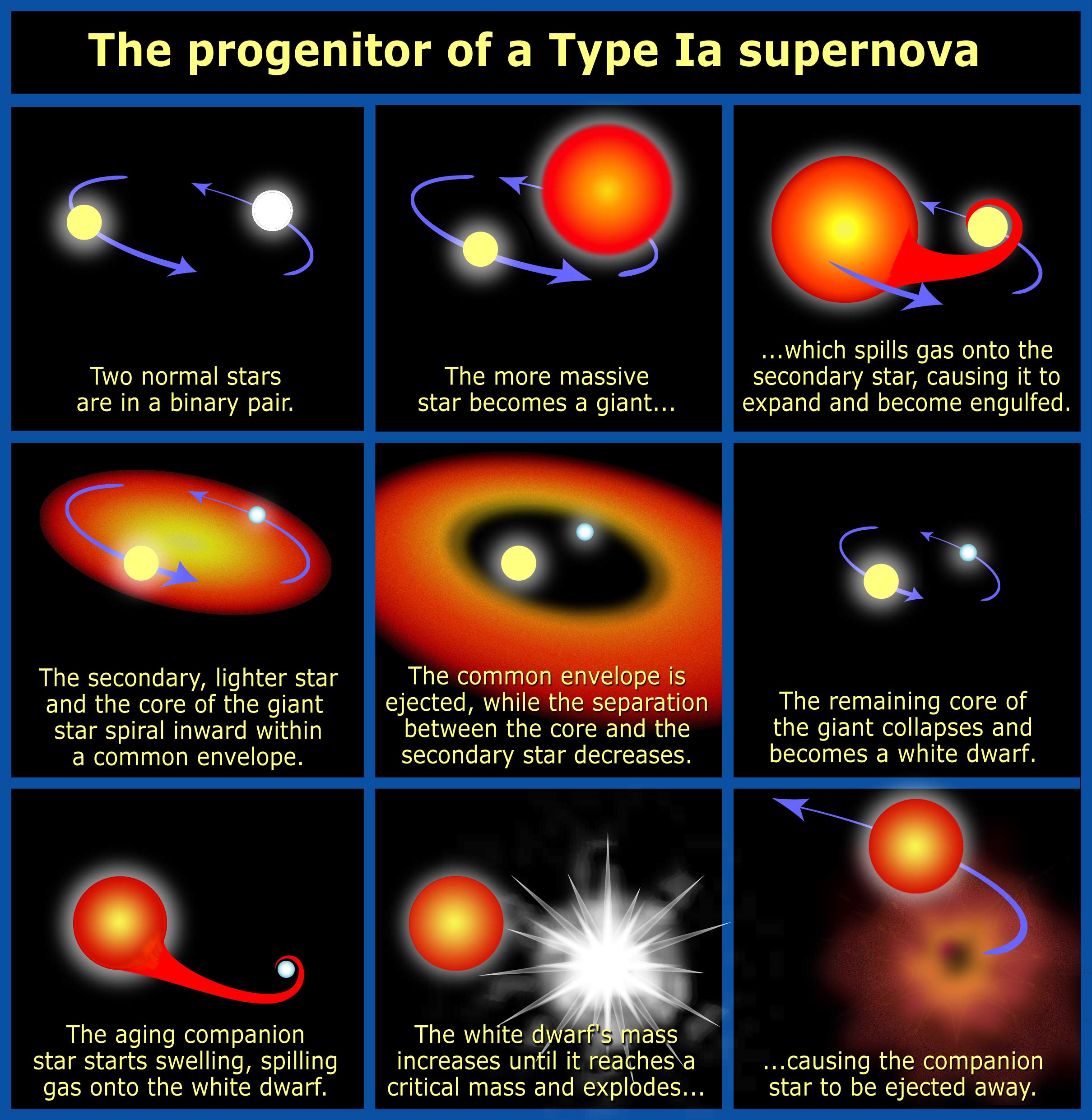PROPERTIES OF WHITE DWARFS
|

|
Evolution to White Dwarfdom
The hot core is initially supported by the degenerate electrons and the hot
nuclei contained in the core. The star follows a well-defined
track in the Hertzprung-Russell diagram.
- Initially, the core slowly cools and loses pressure support
(because the nuclei are not completely negligible). This causes the core
to contract and to get hotter and the
bare core moves to the left in the HR diagram.
- After the nuclei cool to the point where they do not contribute much
pressure support, the degenerate electron pressure essentially halts the
contraction and the core stops heating.
- The hot core now cools without losing pressure support. (This is not
strictly true, however, as the nuclei stil contribute a little tiny
amount of pressure support which means that pressure still decreases a
touch and so the star contracts a touch but does not lead to significant
change in the radius of the star; the white dwarf contracts more or less
at
constant radius
The
cooling process is exceedingly
slow and takes billions or
years
- When the white dwarf becomes cool enough, it can
crystallize forming a solid structure composed of carbon and oxygen.
This theoretical prediction was verified in 2004 with the discovery of the
white dwarf, BPM-37093, located about 50 light years away
in the direction of the constellation of Centarus.
- At an arbitrary point when the white dwarf becomes very cold, we declare
it to be a black dwarf.
Properties of White Dwarfs
White dwarfs are the endpoints of the evolution of low mass stars.
They are interesting
objects in that they are supported by degenerate electron
pressure and thus do not need
internal nuclear energy sources.
White dwarfs radiate because they are born hot and
because they slowly contract releasing gravitational energy as they cool.
White dwarfs cannot be more massive than 1.4 M(sun)
(Chandrasekhar Limit, see below) and
they have radii on the order of the radius of the Earth,
R(wd) ~ 10,000 kilometers. Comment --
this means that white dwarfs are extremely dense; densities on the order
of 200,000
grams per cc to 100,000,000 grams per cc. Recall that the density of lead is ~ 11 grams
per cc. A sugar cube of white dwarf material would weigh anywhere from
400 pounds to 200 tons at the surface of the Earth!
Mass-Radius Relationship
There is a well-defined relationship between the mass of a white dwarf and its
radius. The relationship is not intuitive in that
the larger the mass of the white dwarf, the smaller is its radius!!
This can be understood by noting the size of the degenerate pressure depends on
the density of the gas in such a way that
the pressure is greater when the density is greater.
That is, the higher the density, the higher the pressure and
the harder it is to compress
the white dwarf.
If one thinks a little about the mass-radius relationship, a plausible
scenario arises. Because the more massive the white dwarf, the stronger is the
tendency for gravity to force the white dwarf to contract. To counteract this
tendency, higher pressure is needed (and so higher density is needed) and the
radius of a massive white dwarf must be small to balance gravity.
For a very massive white dwarf, the radius must be tiny.
Question: Is there a limit on how small
one can make the radius of a white dwarf to compensate for an
increase in the mass of the white dwarf?
Answer: Yes, there is a limit. Performing a detailed
analysis, one can show that for a white dwarf of mass
~ 1.4 M(sun), the radius of the white dwarf must be 0 kilometers
in order for the density to be large enough for the
degenerate electron pressure to counter-act the force of gravity.
Huh. Say what?? What does this mean?
This means that there is an upper limit to the mass of a white dwarf. The
limit is ~ 1.4 M(sun) and is referred to as the
Chandrasekar Limit |

|
An interesting possibility for white dwarf evolution concerns white dwarfs
which are in short orbital period (P ~ hours) binary star systems. Such systems
are so small that the white dwarf is actually able to steal material from its
companion star. Such binary systems are known as
cataclysmic variables.
Cataclysmic Variables |

|
Cataclysmic variables are
short orbital period (hours to days) binary
star systems composed of a white dwarf and a low mass main seqeunce
star, in general (sometimes the companion star is a red evolved star).
As their name implies, cataclysmic variables (CV's) are sites for
cataclysmic events. However, the events are not so cataclysmic as to
destroy the binary star systems, usually. The events lead to rapid
increases in the luminosities of the systems.
There are four main types of
cataclcysmic variables (CV's), Dwarf Novae,
Recurrent Novae, Classical Novae, and Type Ia Supernovas.
Many CV's are
strong sources of x-ray emission.
Mass Transfer in Cataclysmic Variables
The systems must have short
orbital periods (hours to a few days) or else the stars will be too far
apart to exchange significant amounts of mass. Let's define some
things.


|
What happens in close binary systems, depends upon the secondary (the less
massive star). There may be
detached, semi-detached, and contact systems depending
upon whether the secondary star fills its Roche lobe. CV's are
semi-detached systems.
The companion fills its Roche lobe and transfers
material to the white dwarf.
|
What Happens in Accreting White Dwarf Binaries?
X_RAY BINARIESGravitational Energy
- The material accelerates as it falls onto the white dwarf. If I
dropped some mass onto a white dwarf it would hit the surface
of the white dwarf at a speed of
around 10,000 kilometers per second. This is
a lot of kinetic energy (gained at the expense of the potential energy
of the white dwarf).
- In dwarf nova systems, the energy which powers the outbursts
is gravitational in nature -- it comes from the energy the material
gained by falling onto the white dwarf.
- Dwarf nova outbursts are smaller and occur much more often (every
several weeks to months) than nova outbursts.
- The release of the gravitational energy can also lead to the production of
x-ray emission near the surface of the white dwarf. The Classical
Nova and Dwarf Nova, GK Per is also a strong source of
x-rays.
|

|
Classical Novae and Type Ia SN, Standardizable Candles?
The common lore is that Classical Novae and
Type Ia SN occur in close mass-transfer binary systems composed of a
white dwarf and a normal companion star, that is,
in
Cataclysmic Variables (CVs).
Recall, CVs are
short orbital period (hours to days) binary star systems composed of a white dwarf and a low mass main seqeunce
star (in general, sometimes the companion star is a red evolved star).
As their name implies, cataclysmic variables (CV's) are sites for
cataclysmic events. However, the events are not so cataclysmic as to
destroy the binary star systems (in general). The events lead to rapid
increases in the luminosities of the systems. Here, we consider the
not so cataclysmic Classical Novae and the very cataclysmic
Type Ia Supernovas. |
 |
Energy Sources for Classical Novae and TYpe Ia Supernovas
CVs generate energy either through nuclear burning or through
gravity (accretion).
Classical Novae and Type Ia Supernovas
power themselves through nuclear energy.
The material which flows onto the white dwarf simply piles up on the
surface of the white dwarf. The material is rich in hydrogen since it
comes from the envelope of the companion star. This is a key point,
because white dwarfs being the ashes of nuclear burning have no nuclear
fuel left. The companion replenishes its fuel supply.
Depending upon whether the mass flow (accretion) is high or low, different
outcomes may result.
For slow accretion rates, the material as it piles up can lose its energy
gained as it fell onto the white dwarf. The material remains cold and reaches
high densities. The scenario is then:
- The material accreted compresses due to the weight of the
recently added material. The compression causes the temperature
and pressure of the accreted material to increase but only slowly.
After around 10,000
to 100,000 years of accretion, the conditions become right for nuclear
burning.
- The ignition of the nuclear burning is not gentle because of the
high densities. The ignition of the burning leads to an explosion
(either because the material is degenerate or the ignition occurs in a
thin shell).
- The thermonuclear explosion causes the nuclear burning shell
to be ejected
leading to a Classical Nova
outburst.
For the fast accretion rate, the material does not have time to lose its
energy it gained as it fell onto the white dwarf. The material thus increases
in temperature and pressure strongly as it accretes onto the white dwarf.
- In this case when the conditions needed for the onset of nuclear burning
are reached, the material is not degenerate and the ignition is gentle,
there is no explosion.
- The ashes of the nuclear burning then just settle onto the core of the
white dwarf increasing its mass.
- This gentle increase in the mass of the white dwarf eventually causes the
white dwarf to approach the Chandrasekhar Mass Limit.
For a carbon/oxygen white dwarf, like the Sun will become, this leads to
ignition of the carbon which causes the entire white dwarf to rapidly undergo
a thermonuclar outburst which incinerates the star. This process leads to a
Type I SN.
- Because the ignition occurs when the white dwarf
is near the Chandrasekhar Mass limit, the progenitor stars for Type I
SN have nearly the same properties. This led to the suggestion that Type I SN
should all appear to be similar in appearance. This is as opposed to Type II
SN where the progenitor have widely differing properties.
Type I SN are thus likely to be Standardizable
Candles







